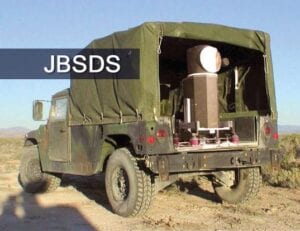A new Defense Advanced Research Projects Agency (DARPA) program seeks technology that may make ultraviolet-based laser detection equipment for chemical and biological defense more readily available in the field.
Raman spectroscopy uses lasers to measure molecular vibrations to quickly and accurately identify unknown substances. Ultraviolet lasers have the optimal wavelength for Raman spectroscopy at stand-off distances, but the DoD’s current UV-based tactical detection systems are large and expensive and have limited functionality.

DARPA’s Laser UV Sources for Tactical Efficient Raman (LUSTER) program seeks proposals for compact, efficient and low-cost deep-UV lasers for highly deployable biological and chemical agent detection. The goal is to create a new class of UV lasers that are more than 300 times smaller than current lasers and 10 times more efficient. The resulting technology could be dropped into current detection systems to save size, weight and power (SWaP) or to create new systems that are smaller and more sensitive.
“Today’s standoff detection systems are so large and heavy that trucks are required to move them,” said Dan Green, DARPA program manager. “LUSTER seeks to develop new laser sources for breakthrough chemical and biological agent detection systems that are compact and light enough to be carried by an individual, while being more efficient than today’s systems. We also want to take a couple of zeroes off the price tag.”
DARPA hopes LUSTER can build on the accomplishments from the recently completed Compact Mid-Ultraviolet Technology (CMUVT) program. CMUVT developed record high-power UV light emitting diodes (LEDs) with high efficiencies and wavelengths approaching those sought under LUSTER. LEDs, however, have limited sensitivity, which is required for discriminating among compounds. LUSTER seeks to develop a new laser technology that has the accuracy of today’s expensive lasers but with the low cost and high reliability of LEDs.
“In addition to detecting chemical and biological agents in the field—or at home to protect against mass terror attacks—UV lasers have many other uses,” said Green. “The new class of UV lasers envisioned from the LUSTER program is expected to impact a broad range of applications such as point-of-need medical diagnostics, advanced manufacturing and compact atomic clocks.”
LUSTER plans to consider a variety of technical approaches, as long as they operate within a 220-240 nanometer wavelength (deep UV) and have greater than 1 watt power production, wall-plug efficiencies greater than 10 percent and line widths less than 0.01 nanometers.
DARPA will host a Proposers’ Day Workshop in support of the LUSTER program on March 18, 2014. Further details are available under Solicitation Number: DARPA-SN-14-26, DARPA-BAA-14-20.


